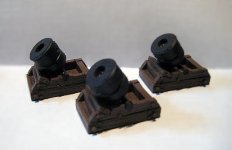This is rivet counting at it's worst, but I believe the 13-inch mortar was a British designation. The French utilized 10 and 12-inch mortars, but I can find no reference to a 13-inch French mortar either before or after the FIW. Montcalm's largest mortars at the siege of Fort William Henry were apparently 10-inch.
A letter from Lord Loudoun to Lord Cumberland (October 1756) lists a single 13-inch mortar at Fort William Henry together with 2 10-inch, 2 8-inch and 3-7 inch mortars. It appears that at least half these mortars were moved out of FWH prior to the siege by Montcalm (August 1757) , probably to Fort Edward. At least 3, if not 4, british mortars burst during the siege (all the British had). Unfortunately for the Britsh, two of these mortars burst during first two days of the siege prior to the first French battery being opened. Apparently, the last mortar burst on the last day of the siege or the night before. During and prior to the FIW, the design of mortars was critically flawed, placing undue stress on the barrel because of an improperly designed powder chamber that slammed the shell against the "lower" barrel wall. The shape of the powder chamber was all wrong.
Bursting was not confined to mortars. At FWH, the British lost almost all of their larger cannon to bursting including 2-32 pounders, 2-18 pounders, 2-12 pounders and 2-10 pounders (Monro's description).
Abercrombie had a 13-inch mortar at his Lake George Camp prior to Ticonderoga. I am unsure if Abercrombie moved this huge massive chunk of metal to the battle itself.


